What led to the eventual success of Jamestown?
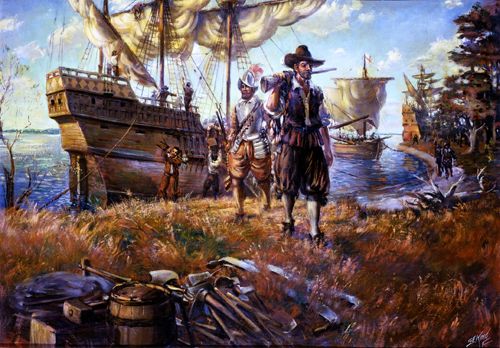
On May 13, 1607, the Jamestown colonists came aground of the offset permanent English settlement in North America. Painting by Sidney E. Male monarch, courtesy Colonial National Historical Park
Historic Jamestown is the site of the first permanent English settlement in North America and represents the very foundations of whom and what nosotros are every bit a people and a nation. Although in that location were other European settlements in America before Jamestown, our linguistic communication, customs, and laws come from our English ancestry. Jamestown is the beginning of America.
Long before the English or any Europeans arrived, Native Americans occupied the continent for thousands of years, and archeological show indicates that they utilized the Jamestown region for over x,000 years. England was a latecomer to the American scene every bit far as exploration. North America had been explored every bit early every bit the 10th century past the Vikings, followed by Christopher Columbus in 1492 and numerous others.
The starting time endeavour at settlement by the English was the fabled lost colony of Roanoke in 1587. Twenty years later, in 1607, England would plant her commencement permanent colony called Jamestown through a joint venture visitor known as the Virginia Company.
It all began on Dec 6, 1606, when three ships: the Susan Constant, the Godspeed, and the Discovery left England bound for America. In early 1607, 104 English men and boys arrived in North America and searched for a settlement place. On May thirteen, 1607, they chose Jamestown, Virginia, named after their Male monarch, James I. The settlement became the offset permanent English settlement in Northward America.
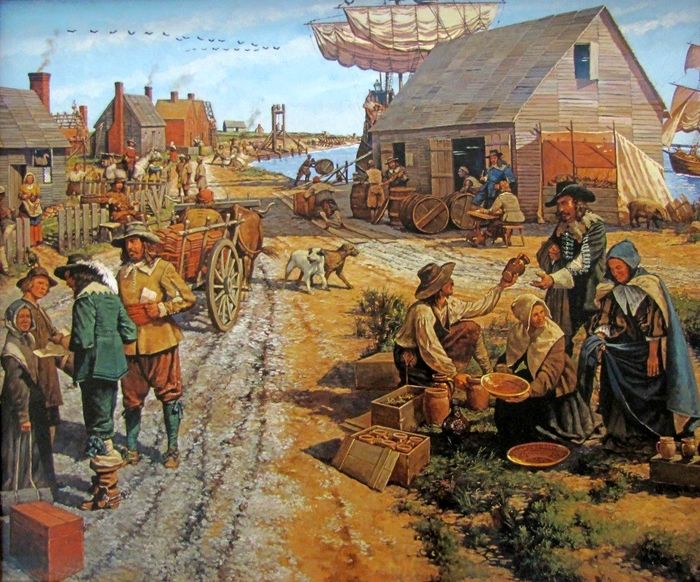
Jamestown, Virginia
The site for Jamestown was picked for several reasons, all of which met the criteria that the Virginia Company, which funded the settlement, said to follow. The site was surrounded by water on three sides (it was not entirely an isle yet) and was far inland, both of which meant it was easily defensible against possible Castilian attacks. The water was likewise deep enough that the English language could necktie their ships at the shoreline, and at the time, the site was non inhabited by Native Americans.
Once the spot was called, the instructions sent by the Virginia Company, which included a list of the council members selected by the visitor, were read. The names had been kept in sealed boxes on the ships, not to exist read until a site was called. The starting time President of the new Virginia colony was Helm Edward Maria Winfield. The other 6 council members included Bartholomew Gosnold, Christopher Newport, John Martin, John Ratcliffe, George Kendall, and Captain John Smith.
By June 15th, a fort was completed. It was triangle-shaped with a bulwark at each corner, holding four or 5 pieces of artillery. The settlers were now protected confronting any attacks from the local Powhatan Indians, whose hunting land they were living on. Earlier the Jamestown immigrants' arrival, relations had already been mixed between the newcomers and the Powhatan Indians. On June 22nd, Helm Christopher Newport left for England to go more supplies for the new settlement.
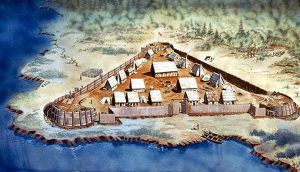
The triangular fort at the Jamestown colony.
When the new settlers first arrived, they had been greeted past friendly Indians who had provided them with lavish feasts and supplies of maize. Withal, equally the English, lacking the inclination to grow their food, became hungry, they began to potent-arm the natives for more and more than supplies. This immediately acquired relations to deteriorate and eventually led to conflict.
Not long after the Captain had sailed, the settlers began to succumb to a multifariousness of diseases. They were drinking water from the salty or slimy river, which acquired the death of many. The expiry cost was high, with the men dying from swellings, malaria, fever, famine, and sometimes, in altercations with the Indians. Nutrient was running low, even though Chief Powhatan had started to ship gifts of food to aid the English. If not for the Powhatan Indians' help in the early on years, the settlement would most likely accept failed.

Jamestown, Virginia Indians
Past late 1609, the human relationship between the Powhatan Indians and the English language had soured as the English were demanding too much food during a drought. The winter of 1609-10 became known as the "Starving Time," and the English had become agape to leave the fort, fearful Indians would kill them. As a result, they ate anything they could, including various animals, leather from their shoes and belts, and even resorting to cannibalism after their fellow settlers died. By early on 1610 well-nigh Jamestown immigrants had died due to starvation and disease, estimated at 80-90%.
In May 1610, shipwrecked settlers who had been stranded in Bermuda finally arrived at Jamestown. Role of a fleet sent the previous fall; the survivors used two boats built on Bermuda to go to Jamestown. Sir Thomas Gates, the newly named governor, establish Jamestown in butchery with the fort'southward palisades torn down, gates off their hinges, and food stores almost non-existent. The decision was fabricated to abandon the settlement. However, less than a day after leaving, Gates and the Jamestown survivors were met by news of an incoming fleet. The armada was bringing their new governor, Lord Delaware, and the men returned to Jamestown.
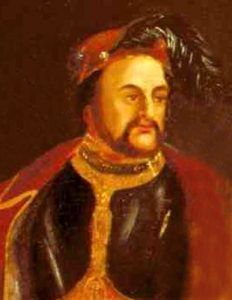
John Rolfe
In 1612, John Rolfe, ane of many shipwrecked on Bermuda, helped plough the settlement into a profitable venture. He introduced a new strain of tobacco from seeds that he brought, and tobacco became the long-awaited greenbacks crop for the Virginia Company, which wanted to make money off their investment in Jamestown.
On July thirty, 1619, newly appointed Governor Yeardley called for the first representative legislative associates. This was the commencement of representative regime in what would become the United states of america of America. In that aforementioned year, the first documented Africans were brought to Virginia on a Dutch privateer ship. Some twenty Africans were traded by the Dutch for food stores from the English. These slaves provided the needed human being resources for labor-intensive tobacco.
Also, in 1619, the Virginia Company recruited and shipped over nigh 90 women to become wives of the English immigrants and then that families could exist started. Though more than a hundred women had arrived in prior years, it was not until 1619 that establishing families became a chief focus.
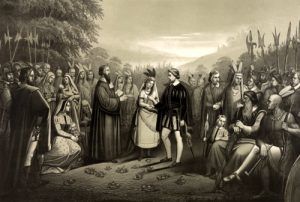
Pocahontas marries John Rolfe, by Joseph Hoover, 1867.
Peace between the Indians and Pocahontas and John Rolfe concluded in 1622. In March of that yr, the paramount primary, Opechancanough, planned a coordinated set on against the English settlements. He was tired of the English language encroachment on Powhatan lands. Jamestown escaped being attacked due to a warning from a Powhatan male child living with the English language; however, some 350-400 of the 1,200 area settlers were killed. Afterwards the attack, the Powhatan Indians withdrew, as was their manner, and waited for the English language to acquire their lesson or pack up and leave. Once the English language regrouped, they retaliated, and in that location was fighting between the two peoples for the side by side decade until a tenuous peace was reached in 1632.
On May 24, 1624, the Virginia Visitor's charter was revoked past King James I due to overwhelming financial problems and politics, and Virginia became a royal colony, which remained until the Revolutionary War. This shift in command did not change the English policy towards the Indians. Despite peace existence declared in 1632, English encroachments on Powhatan lands continued undiminished equally more settlers arrived.
In April 1644, Chief Opechancanough planned another coordinated assail, which resulted in the deaths of another 350-400 of the 8,000 area settlers. The assault ended when Opechancanough was captured in 1646, taken to Jamestown, shot in the back by a guard – against orders – and killed. His successor would later sign the first treaties with the English language, which made the Powhatan Indians subjects of the English.
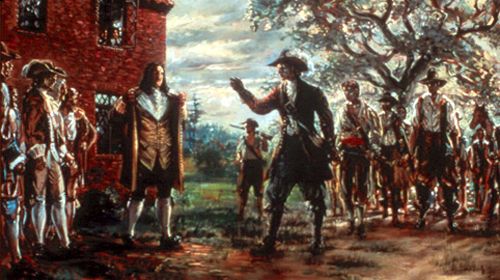
Salary'southward Rebellion
Salary'southward Rebellion, in 1676, saw more struggles in Jamestown. The settlers were unhappy about their tobacco being sold only to English merchants due to the Navigation Acts, high taxes, and attacks on outlying plantations past American Indians. Equally a result, Nathaniel Salary recruited well-nigh one,000 settlers to join him to take intendance of the "Indian Problem." Bacon forced Governor Berkeley to give him an official commission to attack the American Indians responsible for the attacks on the outlying plantations. However, Bacon and his followers did non differentiate betwixt those tribes responsible for the attacks and those loyal to the English language. As a result, Governor Berkeley declared Salary a rebel, and civil war erupted in the colony. In September, Bacon and his followers set fire to Jamestown, destroying 16 to xviii houses, the church building, and the statehouse. Not long after, in Oct, the Rebellion began its end with the death of Nathaniel Bacon. Somewhen, many of the rebels were captured, and Governor Berkeley hung 23.
Subsequently Bacon's Rebellion, another treaty was signed between the English language and the Virginians. More than tribes were function of this treaty than the one of 1646. The treaty prepare more than reservation lands and reinforced a yearly tribute payment of fish and game that the tribes had to brand to the English.
In 1698, burn struck Jamestown once more when a prisoner awaiting execution in the nearby prison started a blaze. The burn destroyed the prison and the statehouse, though many of the public records were saved. In 1699, the government and capital were moved from Jamestown to the Middle Plantation, renamed Williamsburg in honor of King William Three's reigning monarch. A new Capitol building and "Governor'southward Palace" were erected there in the post-obit years.
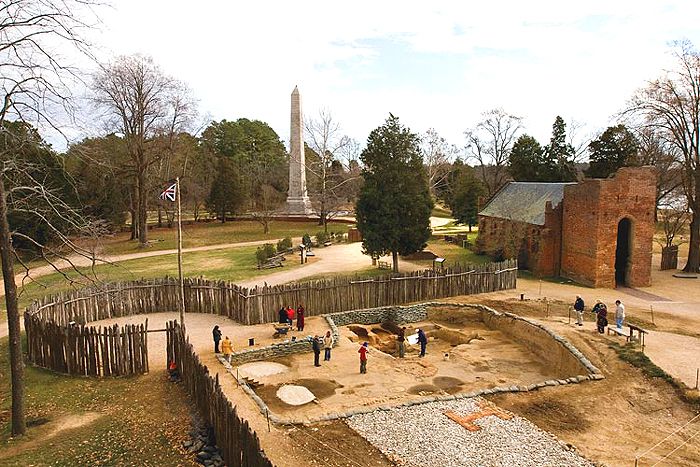
Jamestown, Virginia Today
Due to the movement of the capital to Williamsburg, the old boondocks of Jamestown began to disappear slowly, though farmers connected to live on the isle. Those who lived in the full general area attended services at Jamestown'southward church until the 1750s, when it, too, was abandoned.
Today, Jamestown Island is a National Celebrated site where visitors tin can walk in the steps of Captain John Smith and Pocahontas and the other early on settlers of the first thriving English language colony.
Preserved past the National Park Service and Preservation Virginia, the National Historic Site features an archaeological museum chosen the Archaearium and guided and cocky-guided tours. Sites include the place where the original 1607 James Fort one time stood, the 17th-century church tower, and the location of the 17th-century boondocks. The Jamestown Glass House can besides exist visited, making glass much like it was washed centuries ago at Jamestown. Information technology is part of the Colonial National Historical Park, which provides views of both Old Towne and New Towne, east of the fort, which was first surveyed in the 1620s.
Considering of its strategic location, Jamestown was utilized during the American Revolution. The boxing of Dark-green Spring took identify only a short distance from Jamestown. During the Civil State of war, Confederate forces occupied Jamestown and fortified it with 5 digging.
More Information:

Replicas of the three ships which carried settlers to the Virginia settlement in 1607 are docked in the harbor.
Jamestown National Celebrated Site
P.O. Box 210
Yorktown, Virginia 23690
757-856-1200
Compiled and edited by Kathy Weiser/Legends of America, updated September 2021.
Also See:
Nathaniel Salary — First American Rebel
New England Settlements
The Proprietary Colonies
Settling of America – The Old Dominion
Source: National Park Service
Source: https://www.legendsofamerica.com/va-jamestown/
0 Response to "What led to the eventual success of Jamestown?"
Post a Comment